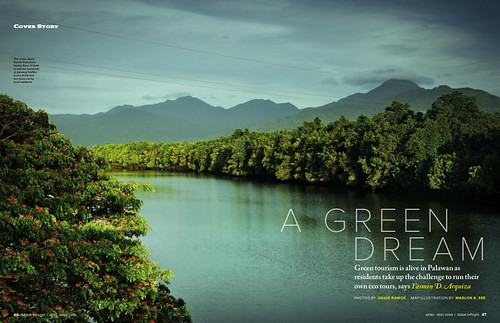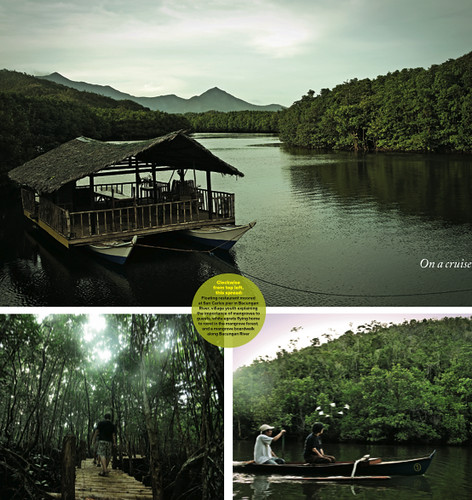 On a cruise down Bacungan River in Barangay Bacungan, home to hundreds of hectares verdant mangrove forest, village wives and their family members prepared and served lunch to tourists on board, while the village youths took turns giving a short lecture with visuals about mangrove ecosystems. It’s not exactly what you’d expect out of a holiday package, but this was no ordinary tour.
On a cruise down Bacungan River in Barangay Bacungan, home to hundreds of hectares verdant mangrove forest, village wives and their family members prepared and served lunch to tourists on board, while the village youths took turns giving a short lecture with visuals about mangrove ecosystems. It’s not exactly what you’d expect out of a holiday package, but this was no ordinary tour.Those organizing the tour are residents of Bacungan, some 20 kilometers north of Puerto Princesa City, capital of Palawan. Most of them had been involved in cutting down the very mangroves they are now protecting and showing off to visitors.
Under private sector ABS-CBN Foundation's Bayanijuan project, local folks are finding new ways of earning a living the eco friendly way. The foundation has helped organize communities and provides funds for equipment to get locals started. Non-governmental organizations (NGOs) are also supporting similar projects. As a result, five eco tours, including the Bacungan River tour, are successfully being operated by local people. In Bacungan, residents abandoned mangrove cutting soon after the Environmental Legal Assistance Center (ELAC), an NGO engaged in environmental advocacy in Palawan, started a series of talks to villagers about the adverse effects of destroying the mangroves, a rampant practice because profit can be had from selling mangroves as charcoal. In 2003, ELAC’s efforts were helped by the government when it awarded the Bacungan Coastal Development Residents’ Association a 25-year government lease covering all 379 hectares of mangrove forests. This award put the association in charge of managing the forest and protecting it from illegal activities.
In Bacungan, residents abandoned mangrove cutting soon after the Environmental Legal Assistance Center (ELAC), an NGO engaged in environmental advocacy in Palawan, started a series of talks to villagers about the adverse effects of destroying the mangroves, a rampant practice because profit can be had from selling mangroves as charcoal. In 2003, ELAC’s efforts were helped by the government when it awarded the Bacungan Coastal Development Residents’ Association a 25-year government lease covering all 379 hectares of mangrove forests. This award put the association in charge of managing the forest and protecting it from illegal activities.
 In Bacungan, residents abandoned mangrove cutting soon after the Environmental Legal Assistance Center (ELAC), an NGO engaged in environmental advocacy in Palawan, started a series of talks to villagers about the adverse effects of destroying the mangroves, a rampant practice because profit can be had from selling mangroves as charcoal. In 2003, ELAC’s efforts were helped by the government when it awarded the Bacungan Coastal Development Residents’ Association a 25-year government lease covering all 379 hectares of mangrove forests. This award put the association in charge of managing the forest and protecting it from illegal activities.
In Bacungan, residents abandoned mangrove cutting soon after the Environmental Legal Assistance Center (ELAC), an NGO engaged in environmental advocacy in Palawan, started a series of talks to villagers about the adverse effects of destroying the mangroves, a rampant practice because profit can be had from selling mangroves as charcoal. In 2003, ELAC’s efforts were helped by the government when it awarded the Bacungan Coastal Development Residents’ Association a 25-year government lease covering all 379 hectares of mangrove forests. This award put the association in charge of managing the forest and protecting it from illegal activities.The break in mangrove-cutting activities – hopefully a permanent one – encouraged white egrets to come back and resulted in more fish in the river, according to Agustin Mapa, former charcoal gatherer who now heads the Bacungan Coastal Development Residents’ Association. Building on ELAC’s organizing efforts, Bayanijuan helped the community develop the eco tour.
One of the five eco tours now on offer, the mangrove cruise tour itself is an enjoyable two-hour travel with a stopover at an 85-meter boardwalk where you get to see the mangroves up close. The cruise is on a floating restaurant, a platform mounted on two boats, catamaran-style, towed by an outrigger boat. Tourists get on the boat in Sitio San Carlos, welcomed by young children in native costumes performing local folk dances while a string band played Cuyunon music. A sachet of insect repellent to ward off sand fleas known to swarm in mangroves were passed on to everyone. Lunch consisted of jackfruit salad, chicken soup, fish stew with fresh tomato dip, crabs caught from the river, and rice in banana leaves. The serenity of the mangrove river lulled some of the guests to sleep during the lazy Sunday afternoon cruise.
The tour costs P3,500 for a minimum of 10 people, and includes native snacks and fresh buko (young coconut). Buffet lunch is an additional P150, a bargain for such a feast. Every trip, 14 households earn extra income from organizing the tour. Everyone from the children to the parents help out in cooking, entertaining, and briefing visitors.
(This is part 4 of the cover feature, "The Green Dream" by Yasmin Arquiza for Seair Inflight Magazine, April-May 2009 issue. Art direction by Jocas See • Photography by Oggie Ramos)
